Break Bread Meaning in Bible: Communion and Fellowship
The phrase ‘break bread‘ in the Bible originates from Jewish meal-sharing traditions, symbolizing fellowship, covenant, and divine provision. In the Old Scriptures, it underscores communal and covenantal relationships.
Jesus’ Last Supper reinterprets this practice, using bread to represent His body and wine His blood, establishing a New Covenant. Early Christians adopted this in their communal practices, fostering unity and remembrance of Christ’s sacrifice.
This ritual, now central to Christian worship, not only honors Jesus’ sacrifice but also strengthens the bonds within the faith community, reflecting a life of shared spiritual commitment. For more profound insights, explore further.

Break Bread Meaning in the Bible: Symbolism and Spiritual Significance
| Aspect | Details |
|---|---|
| Definition | The act of sharing bread, often symbolizing unity and communion |
| Key Bible Reference | Last Supper with Jesus and His disciples (Luke 22:19) |
| Symbolic Meaning | Fellowship, covenant, sacrifice, and remembrance of Christ’s body |
| Spiritual Insight | Breaking bread reflects spiritual unity and the sharing of God’s grace |
| Moral Lesson | True community is built through shared faith, remembrance, and humility |
Biblical Origins
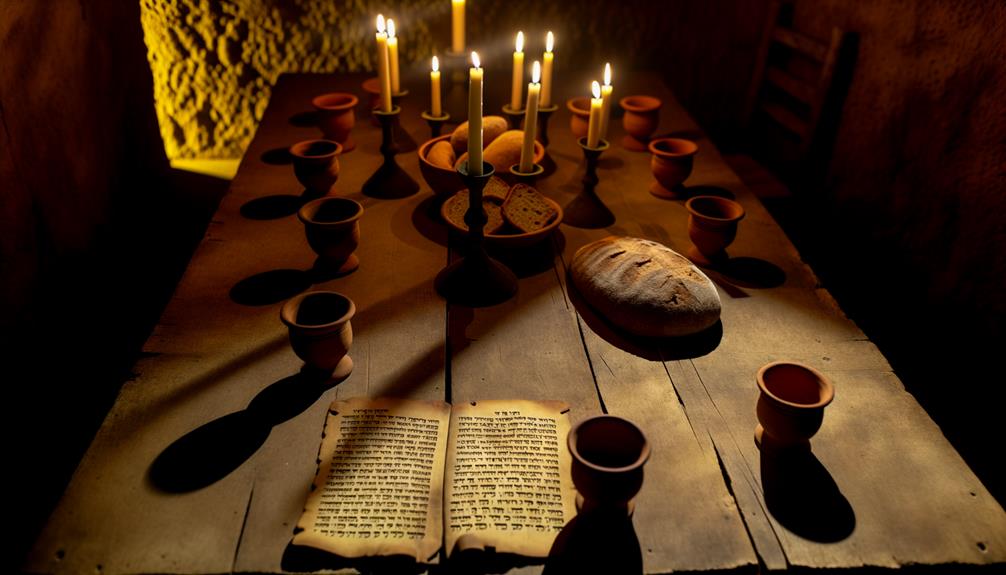
The phrase ‘break bread‘ finds its biblical origins in the Jewish tradition of sharing meals, which is deeply rooted in the Old Scriptures and carries significant theological implications in the New Scriptures.
This practice is more than a mere act of eating; it symbolizes fellowship, covenant, and divine provision.
In the New Covenant, specifically in the Gospels and Acts, ‘breaking bread’ extends to the communal and sacramental contexts, particularly in the Last Supper and early Christian gatherings.
These events underscore a spiritual unity among believers and a remembrance of Christ’s sacrifice.
Consequently, ‘breaking bread’ evolves from a cultural ritual to a profound expression of faith and community within the Christian tradition, bridging the Old and New Covenants.
Old Testament References
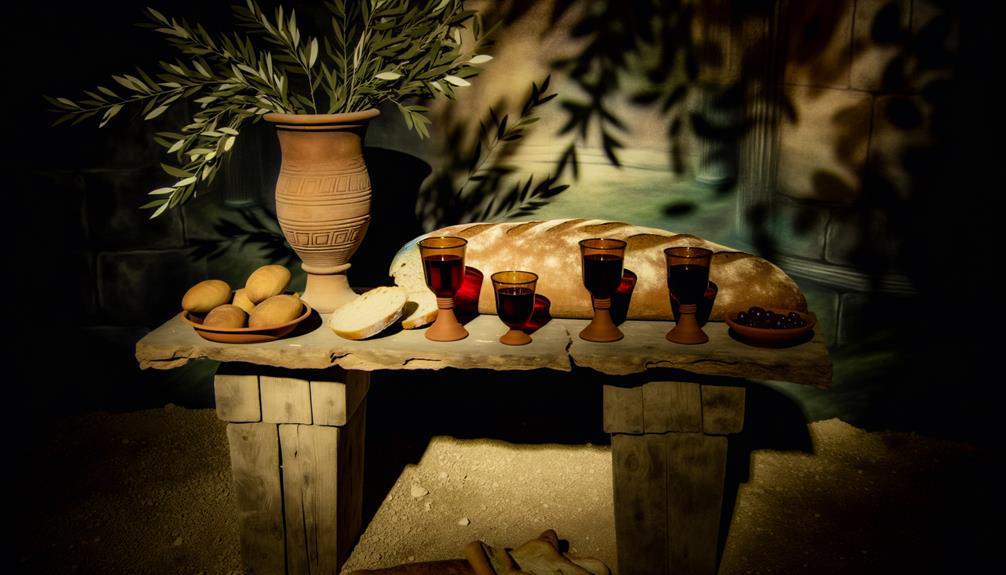
Ancient Scripture references to ‘breaking bread’ frequently illustrate communal meals that reinforce covenantal relationships and divine hospitality. In the Old Covenant, these references are rich in theological and social significance.
For instance, bread-breaking ceremonies often accompany covenant renewals and divine encounters. Examples include:
- Genesis 14:18: Melchizedek, king of Salem, brings bread and wine to Abraham, symbolizing divine blessing.
- Exodus 12:8: The Passover meal includes unleavened bread, signifying deliverance and covenant with God.
- 1 Samuel 9:13: Samuel invites Saul to a sacrificial meal, a sign of divine favor and prophetic calling.
These instances underscore the sacred nature of communal eating in establishing and remembering divine covenants.
Jesus and the Last Supper
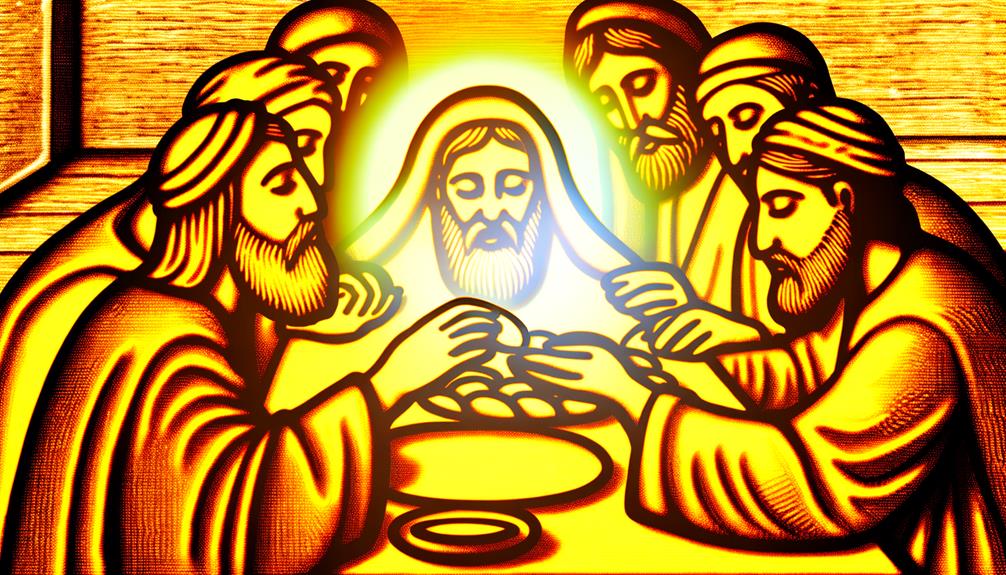
Jesus’ institution of the Last Supper marks a pivotal moment in Christian theology, as it transforms the traditional Passover meal into a profound enactment of the New Covenant. During this meal, Jesus broke bread and shared wine with His disciples, symbolizing His imminent sacrifice. This act established a new ritual for believers, emphasizing unity and remembrance of Christ’s atoning death. The Last Supper encapsulated themes of redemption and divine promise, reinforcing Jesus’ role as the sacrificial Lamb.
| Aspect | Old Covenant | New Covenant |
|---|---|---|
| Meal | Passover | Last Supper |
| Symbolizes | Exodus from Egypt | Jesus’ Sacrifice |
| Elements Used | Lamb, Unleavened Bread | Bread, Wine |
| Central Figure | Moses | Jesus |
| Purpose | Commemorate Exodus | Remember Christ’s Death |
This transformation underscores the continuity and fulfillment of Old Scripture prophecies through Jesus Christ.
Symbolism in Communion
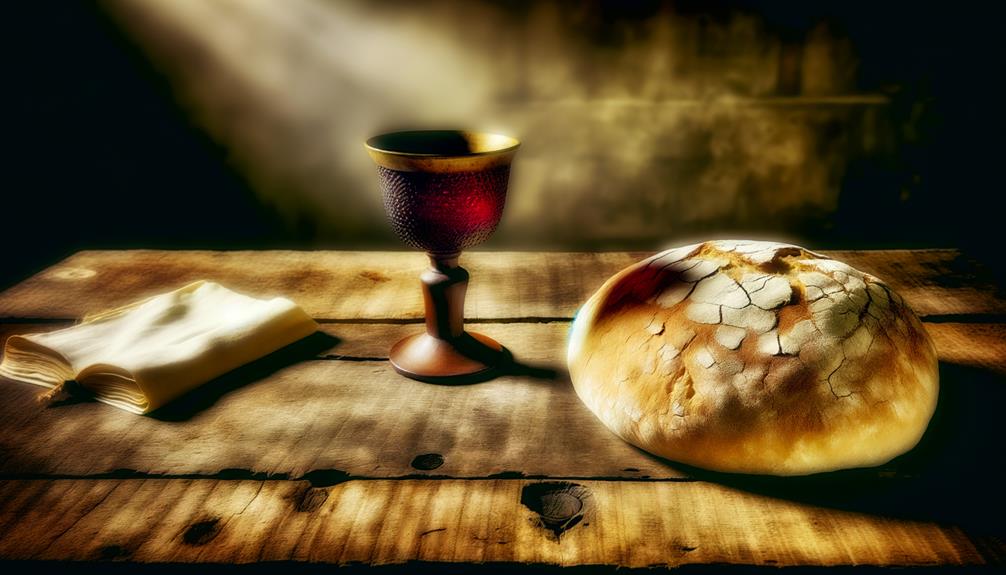
In Christian practice, Communion serves as a profound ritual imbued with rich symbolism, reflecting the core tenets of faith and the redemptive work of Christ. The act of breaking bread and sharing the cup is deeply emblematic, invoking the sacrifice of Jesus and the new covenant established through His blood.
The symbolism in Communion can be appreciated through several key elements:
- Bread: Represents the body of Christ, broken for humanity’s sins.
- Wine: Symbolizes the blood of Christ, shed for the forgiveness of sins.
- Communal participation: Reflects the unity of believers in Christ.
These elements together encapsulate the theological essence of Communion, making it a cornerstone of Christian worship and identity.
Fellowship and Unity
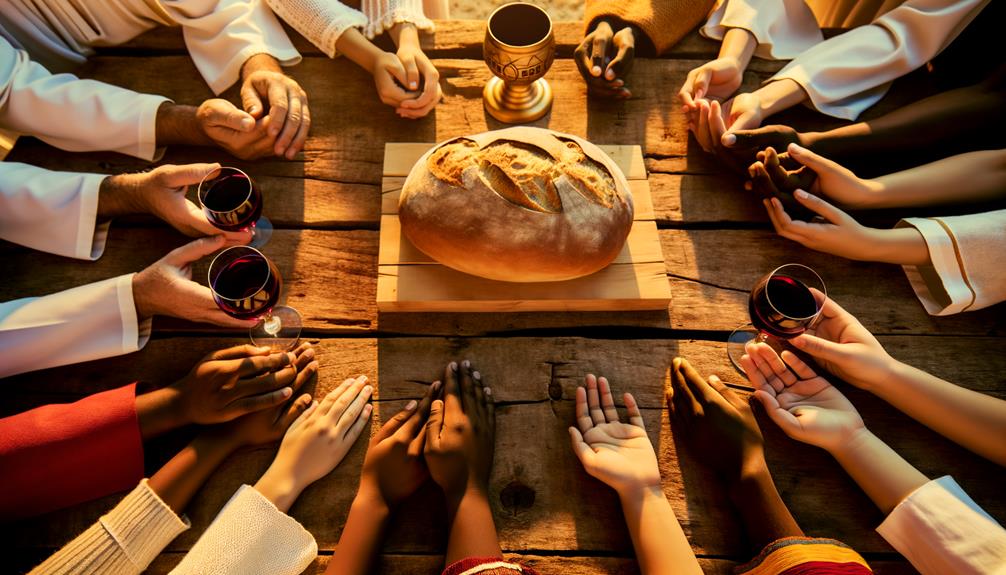
Frequently, the act of breaking bread in the Bible is a powerful symbol of fellowship and unity among believers, emphasizing the communal nature of the Christian faith. This practice encapsulates the essence of shared life and mutual support within the early Christian communities.
It signifies not only participation in the body of Christ but also a commitment to one another as members of a unified body. This sacred act reinforces the idea that faith is lived out in community, fostering a deep sense of belonging and interconnectedness.
| Aspect | Explanation |
|---|---|
| Fellowship | Shared meals enhance relational bonds |
| Unity | Symbolizes oneness in Christ |
| Communal Nature | Reflects early Christian communal practices |
These elements collectively underscore the holistic and communal dimensions of Christian worship.
Breaking Bread in Acts
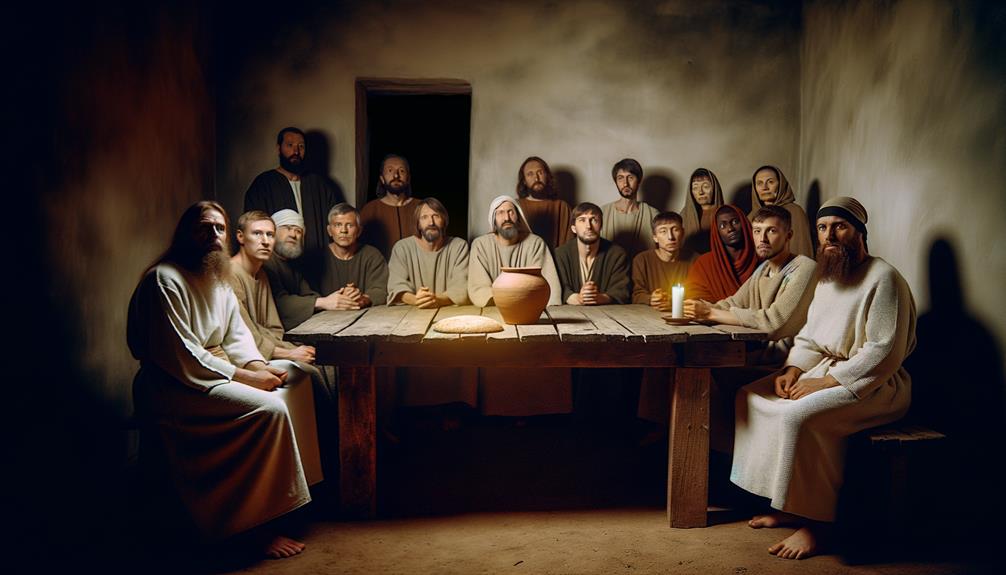
The practice of breaking bread as depicted in the Book of Acts exemplifies the early Christian tradition of gathering together for communal meals, which served as both a spiritual and social cornerstone for the nascent Church. These gatherings were profoundly significant, fostering unity and mutual support among believers.
- Acts 2:42: ‘They devoted themselves to the apostles’ teaching and to fellowship, to the breaking of bread and to prayer.’
- Acts 2:46: ‘Every day they continued to meet together in the temple courts. They broke bread in their homes and ate together with glad and sincere hearts.’
- Symbol of Fellowship: Breaking bread symbolized a shared life in Christ’s teachings.
These instances highlight the centrality of shared meals in early Christian worship and fellowship.
Eucharist in Early Church
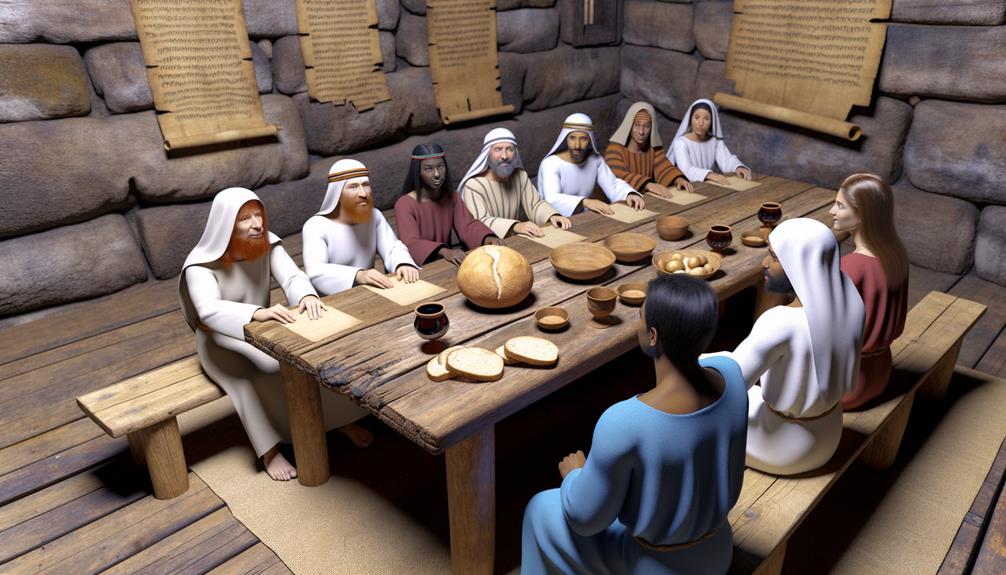
The Eucharist, rooted in the Last Supper, became a central sacrament in the early Church, symbolizing Christ’s sacrifice and unity among believers.
Early Christian communities practiced Communion with a deep sense of reverence, following liturgical traditions that underscored its theological significance.
This sacred rite was not just a ritual but a profound expression of faith, encapsulating the essence of Christian worship and communal identity.
Origins of the Eucharist
Drawing from Jewish traditions and the Last Supper of Jesus, the early Church developed the Eucharist as a central act of worship symbolizing Christ’s sacrifice and communal fellowship.
The Jewish Passover meal, with its ritual bread and wine, served as a foundational model. Jesus’ breaking of bread and sharing of the cup at the Last Supper became a template for this sacred practice. Early Christian writings, such as those by Paul in 1 Corinthians, provide evidence of the Eucharist’s integral role.
- Significance: Represents the New Covenant in Jesus’ blood.
- Frequency: Early Christians observed it regularly, often weekly.
- Community: Fostered unity and shared faith among believers.
Communion Practices Explained
Early Christian communities observed the Eucharist through well-structured rituals that emphasized both theological significance and communal unity.
These early practices were deeply rooted in the Last Supper, where Jesus instructed His disciples to ‘do this in remembrance of me’ (Luke 22:19). The Eucharist was seen as a profound expression of Christ’s sacrificial love and a means of participating in His divine life.
Liturgical frameworks, such as those found in the Didache and writings of Church Fathers like Justin Martyr, reveal a consistent pattern: prayers of thanksgiving, the breaking of bread, and the sharing of the cup.
These elements underscored the believers’ shared faith and mutual commitment, reinforcing the early Church’s identity as the Body of Christ.
Modern Christian Practices
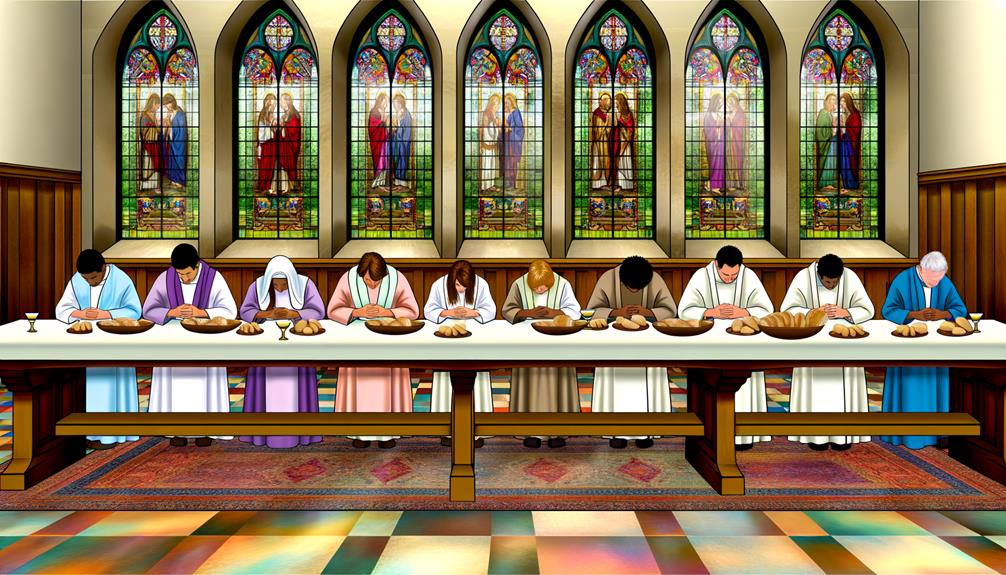
In contemporary Christian communities, the practice of breaking bread continues through the sacraments of Communion, which symbolizes unity with Christ and among believers.
Additionally, community meal traditions reflect the early Church’s emphasis on fellowship and shared faith experiences, fostering a sense of belonging and mutual support.
These practices remain essential expressions of spiritual and communal life, deeply rooted in biblical teachings and historical precedent.
Communion and Fellowship
While the act of breaking bread in the Bible is deeply rooted in ancient traditions, modern Christian practices of communion and fellowship continue to embody its profound spiritual significance.
Today, communion is not merely a ritual but a means of fostering spiritual unity among believers, reflective of the Last Supper where Jesus shared bread and wine with His disciples. Fellowship extends this sacred act into daily life, emphasizing communal bonds and mutual support.
- Sacramental Participation: Communion is observed as a sacrament, affirming faith and remembrance of Christ’s sacrifice.
- Shared Meals: Fellowship often includes shared meals, echoing the communal practices of the early Church.
- Spiritual Nourishment: Both communion and fellowship provide spiritual sustenance and growth.
Community Meal Traditions
Modern Christian practices of community meal traditions build upon the biblical foundation of breaking bread, emphasizing the importance of shared experiences and collective worship in nurturing faith.
These traditions often manifest in the form of potlucks, church suppers, and fellowship meals, reflecting the early Christian gatherings described in Acts 2:42-47.
Such communal meals serve not only as opportunities for fellowship but also as a tangible expression of Christ’s love and unity within the body of believers.
By sharing food and time, modern Christians create an environment where faith is strengthened through mutual support, prayer, and the breaking of bread together.
These practices underscore the enduring relevance of biblical principles in contemporary Christian life, fostering deeper connections within the faith community.
Spiritual Reflection
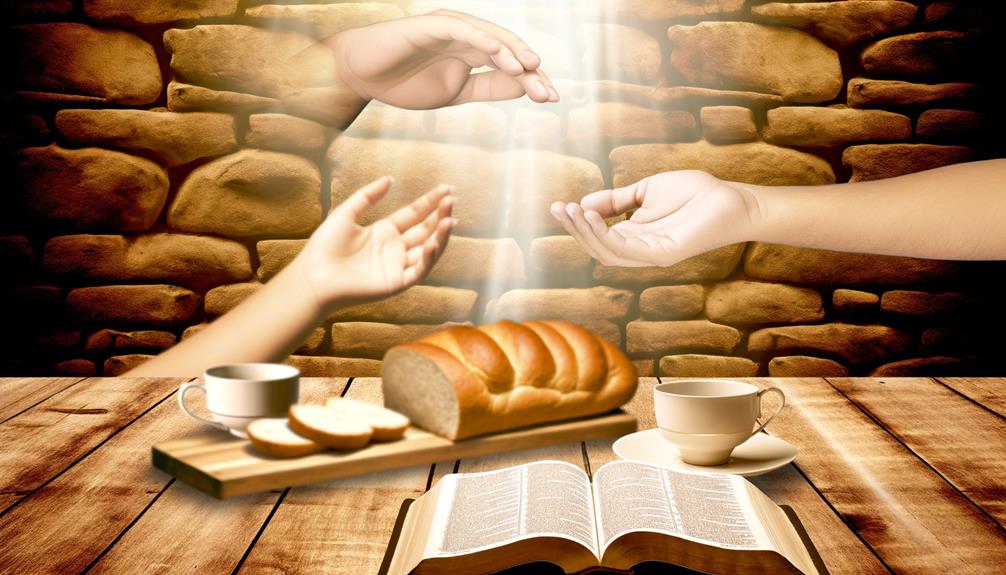
Drawing upon the profound symbolism of breaking bread in the Bible, one can find a rich tapestry of spiritual reflection that underscores the themes of unity, fellowship, and divine grace. This act, representing Christ’s body, invites believers to engage in deeper communal and personal spirituality.
By partaking in the breaking of bread, Christians are reminded of:
- Unity: The shared meal signifies the oneness of the Body of Christ.
- Fellowship: It fosters a sense of belonging and mutual support within the faith community.
- Divine Grace: It is a tangible expression of Jesus’ sacrificial love and grace offered to humanity.
Thus, breaking bread is a profound spiritual practice rooted in biblical tradition.
Conclusion
The practice of breaking bread, deeply rooted in biblical tradition, embodies profound theological and communal significance.
From the Old Scriptures to modern Christian practices, it symbolizes unity, fellowship, and remembrance of Christ’s sacrifice.
Particularly, over 2 billion Christians worldwide partake in the Eucharist, underscoring its enduring importance.
This act not only commemorates Jesus’ Last Supper but also fosters a sense of spiritual solidarity, transcending cultural and denominational boundaries, thereby reinforcing the global Christian community.






